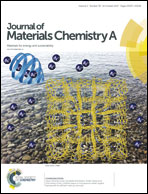Ultrathin nanoporous membranes derived from protein-based nanospheres for high-performance smart molecular filtration†
Abstract
Flexible ultrathin nanoporous membranes composed of closely packed nanospheres with diameters of ∼11 nm are fabricated from natural Bombyx mori silk fibroin via a vacuum filtration process. The resultant membranes have controllable thicknesses from 49 nm to several micrometers and tunable pore sizes ranging from 8 to 14 nm. These membranes exhibited extremely high permeation flux and displayed excellent separation efficiency for various molecules including proteins, nanoparticles and dyes. The 49 nm thick membrane, for instance, has a pure water flux of up to 13 888 L m−2 h−1 bar−1, which was almost three orders of magnitude higher than those of most commercial filtration membranes, while retaining a 95% rejection of bovine serum albumin. More importantly, the membranes exhibit outstanding selective transport performance for various dye mixtures. The facile fabrication strategy for nanospheres and nanoporous membranes is versatile and scalable to various other proteins. The renewable construction materials, facile fabrication process, inspiring permeability and excellent separation efficiency make these membranes attractive for effective and economically feasible molecular filtration.



 Please wait while we load your content...
Please wait while we load your content...